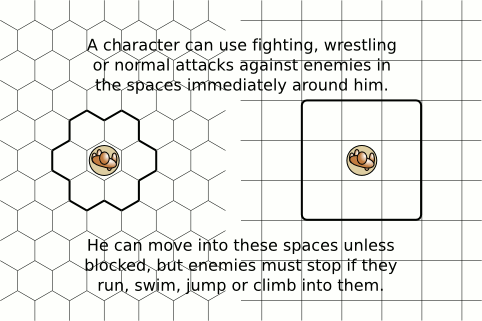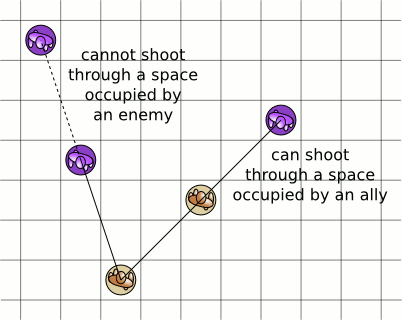Scratch:Grid
Use the Grid variation of the Scratch RPS if you are using miniatures or tokens to represent characters on a hex map or square grid like a dungeon map or chessboard. This variation is not designed for combat between vehicles.
Movement[edit]
Spaces usually represent an area about 2 meters wide. Each character has 4 spaces of movement when he is healthy and 2 spaces of movement when he is injured. It takes 2 spaces of movement to move 1 space over rough terrain or in water. Rough terrain includes climbing, jumping, swinging, and tightrope walking.
- Every 2 levels of quickness gives a character 1 extra space of ground movement. This space cannot be used to move over rough terrain or in water.
- Every 2 levels of flying gives a character 1 extra space of air movement. This space cannot be used to move in tight places where you cannot fly.
- Every level of acrobatics gives a character 1 extra space of rough terrain movement, but it still takes 2 of these spaces to move 1 space over rough terrain. This space cannot be used to move over level ground or in water.
- Every level of swimming gives a character 1 extra space of water movement, but it still takes 2 of these spaces to move 1 space in water. This space cannot be used to move over ground or rough terrain.
Each character can move on his turn if he is not incapacitated or immobilized. the character can move before or after performing an action, but only once per turn. He can move into any of the spaces around his current space if that space is not blocked by a wall, obstacle or enemy. A character can move through spaces occupied by allies if he does not stop on that space. When a character moves into a space next to an enemy, the character cannot do any more moving during that turn.

Actions[edit]
To use healing ability, a character must be in a space next to the character he is healing or reviving.
Close range attacks (basic attacks, holds or knockout attacks) can hit a target in any of the spaces next to the attacker's space. A successful hold immobilizes the target until the end of the target's next turn and allows the attacker to swap places with the enemy or move the enemy 1 space in any direction that is not blocked by a character, wall or other obstacle.
Long range attacks (throw object, shooting or blasting) can hit targets further away as long as the line-of-sight between the attacker and target is not blocked by walls, obstacles or enemies. A character can shoot through spaces occupied by his allies without hitting them. Blasting targets an occupied or empty space, attacking every character (including allies) within one space of that target (a maximum of 9 characters on a square grid or 7 characters on a hex grid.)

Interrupting Attacks[edit]
An interrupting attack is a close range attack a character can do immediately when an opponent within 1 space exposes himself to the attack. A character exposes himself to an interrupting attack when he moves more than 1 space, evades or attacks an enemy more than 1 space away from himself.
Make a fighting, wrestling or knockout roll against the enemy's agility. If the attack succeeds, it causes no damage, but it prevents the target from completing the movement or action which exposed him to interrupting attacks. A successful interrupting attack also ends the target’s turn, removes the target's evade bonus if the target is evading, and prevents the target from escaping on his next turn.
Characters who are injured, incapacitated or unable to perform actions cannot do an interrupting attack. A character who is delayed by a wrestling attack cannot perform actions, so he cannot perform interrupting attacks.
A character may only attempt one interrupting attack during each turn of each target who exposes himself to interrupting attacks, even if a target exposes himself to interrupting attacks several times on the same turn.
Escaping[edit]
To escape, a character must move into a special exit space or off the edge of the map. Characters trying to escape should start their turn with an evade action before moving, instead of moving first and then evading. This way they receive the extra bonus to agility from evading. This extra defense can help the escaping character avoid interrupting attacks.